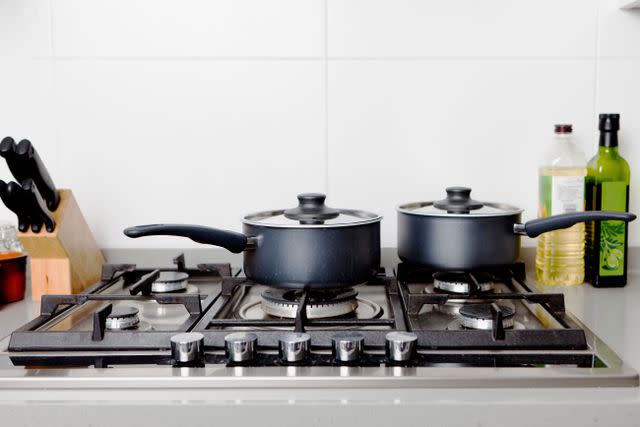5 Kitchen Trends We Won't See in 2024
Don't let your kitchen get stuck in the past!
From a sleek aesthetic to new appliances that work perfectly, there’s nothing quite like having a freshly renovated kitchen for cooking meals and spending time with your family. But a new kitchen is a major investment that takes many months (maybe even years) of planning. So, it's crucial to get things right and make sure your new kitchen is as updated as possible. Of course, we always say to decorate in whatever way makes you happy, but if you want to be sure your kitchen design won't look dated in a few years, there are some design fads you may want to skip. Here are five kitchen trends we won’t see in 2024.
Related: 14 Kitchen Trends Taking Over the Design Industry in 2024

Image Source/Getty Images
Gas Appliances
According to Mindy O'Connor, principal and founder of Melinda Kelson O'Connor Architecture & Interiors, gas appliances are falling out of favor. “Between the more numerous options and increasing legislation incentivizing homeowners to wean off of gas appliances—induction cooktops and electric ovens will hopefully take hold in more of the American marketplace,” she says. “An enormous amount of options for induction cooktops and induction ranges with electric ovens are coming out in both 36-inch and recently even 48-inch sizes as these technologies become more comfortable and attractive to homeowners.”
So, if you plan to renovate in 2024, it’s best to consider a range of ranges, whether you plan to sell shortly or stay in your home for years to come.
Open Plans by Default
For the past decade, open-plan kitchens have been the default for new homes and renovations. But this is likely to change in the coming year, explains O’Connor. “In some cases, opening up your kitchen to the dining or living space allows for a modern and comfortable feeling and function in the kitchen and a better connection to the rest of the house. However, what should actually determine the layout and arrangement of rooms in any house are the innate characteristics of its architecture, the intended use and circulation, the available light, and the client's objectives. Let the house itself and sound design principles help you develop the best use of what you have.”
Can’t decide between an open and closed kitchen? O’Connor has a smart solution. “Pocketed glass doors can also create combined open spaces that can still be closed to allow for different uses and occasions, and control sound between connected rooms where there may be a television or party.”
All-White Kitchens
All-white kitchens have reigned in recent years, but they’re going to look dated by the time 2024 comes around. “All-white kitchens have been a mainstay in design for the past decade. However, we are now noticing consumers gravitating toward warmer hues for cabinetry and darker-toned countertops,” says interior designer Audrey Scheck. “We’re seeing lots of mushroom beige and muddy green cabinetry paired with a dark gray or black countertop.”
Quartz Countertops
Quartz countertops were a key component of the all-white kitchen aesthetic because quartz looks like marble, yet is more durable and a better price. So, as white kitchens drop off, so will this material. “While quartz countertops will always remain a smart and economical choice, we’re seeing a shift toward natural stone countertops such as marble and quartzite. Now more than ever, there seems to be an appreciation for a perfectly imperfect stone that exudes character,” Scheck explains.
Stainless Steel
While stainless steel appliances are timeless, panel-ready appliances will start to become a more popular choice next year. “Panel-ready appliances allow for a custom panel to be installed on top of a refrigerator or dishwasher to seamlessly integrate them into kitchen cabinetry,” Scheck says.
Stainless steel vent hoods are also on their way out. “Gone are the days of not capitalizing on the vent hood as a design opportunity in the kitchen. Be prepared to see even more intricate, well-thought-out vent hood integrations through the use of materials such as plaster, wood, and tile.”
For more Real Simple news, make sure to sign up for our newsletter!
Read the original article on Real Simple.


